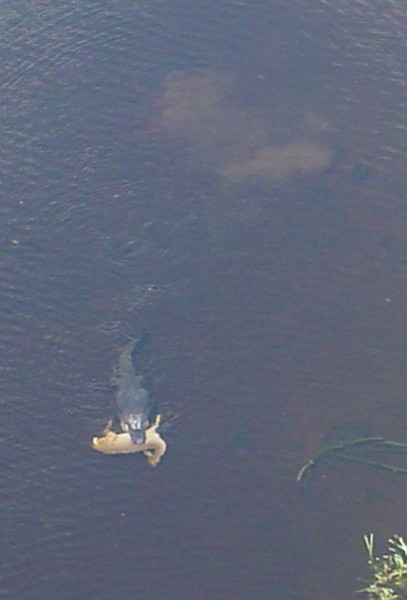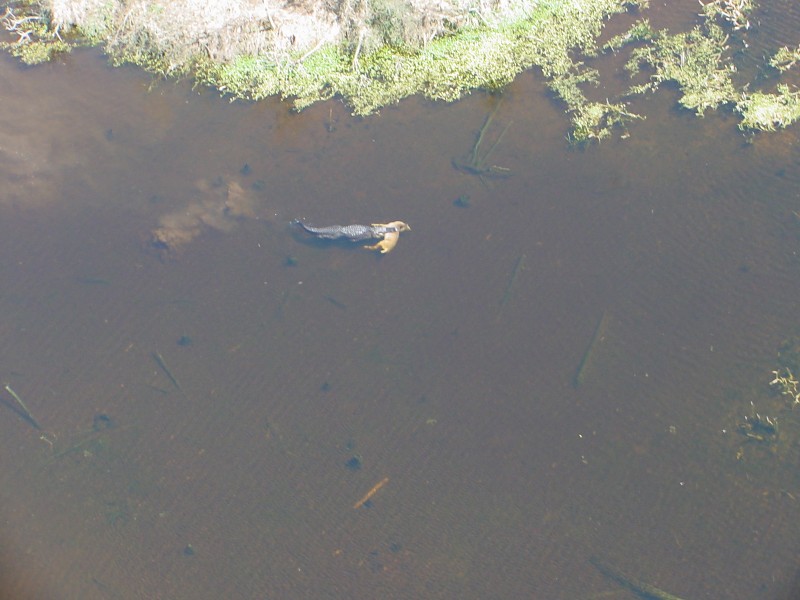5 Internet Deer Legends That Are True
Daniel Xu 12.08.15

Whoa. That gator just took a deer to lunch.
Continuing with our series on internet myths regarding our favorite game animals (read our article on debunking legends about moose here), we decided this week to clear up strange stories about America’s most popular big game species, deer. Here are five strange deer and deer-related phenomena that you probably have already seen before, whether on Facebook, Twitter, or through “old school” email chains. Which ones did you think were fake?
1. The calico buck

The pictures of this strangely-colored buck have been floating around the internet since at least 2009. Descriptions of the deer, however, can be misleading. The text that often accompanied the photo claimed that the deer was killed in Wisconsin and later sold to the owner of one outdoor retail chain or another for a whopping $13,000. That’s pure embellishment. Sometimes the prize for bagging a deer as rare as this one is simply the honor of mounting it.
According to buckmanager.com, the piebald “calico buck” was actually harvested by James Curtis on a privately owned ranch outside of Palestine, Texas. The deer scored 138 5/8 gross and had a total body weight of 195 pounds. Its unique piebald pattern was what made the deer so popular, although piebald deer in general are relatively rare. According to some estimates, less than one percent of wild deer are piebald.
2. The black whitetail fawn

We’ve heard of albino and piebald deer, but a black fawn? How did that happen? This image of a black-colored whitetail fawn first surfaced in 2010, and despite suspicions of it being photoshopped, was later confirmed to be real. According to Snopes.com, a website dedicated to revealing urban legends and mysteries, the photo was actually taken by nature photographer Richard Buquoi.
The black coloring is a result of a genetic variation called melanism. Melanism is the opposite of albinism and instead of having an absence of pigment melanin, the animal instead has an abundance of dark-colored melanin. Scientists believe it was first adapted as a defense against nighttime predators. Deer in certain regions are more likely to develop this condition, although experts are unsure to just how much of an advantage it gives them.
3. The 430-pound buck

This beefy buck first appeared in 2009 but went viral in 2014 by the way of social media and email. Claims of where it was harvested, how much it weighed, and exactly why it looked so large varied. The most popular rumor appears to be that the buck was taken in Michigan and weighed 430 pounds. The weight is close, but the location is not.
This deer came from a high-fence facility in Wisconsin, if that makes it easier to believe. In 2010 the owner of Wilderness Whitetails, Shorty Flees, told Field & Stream that the buck was taken at the end of a 11-day hunt in 2009 and that it weighed 420 pounds total.
“Yes, it is a legitimate buck. I mean, we are a high-fence operation, I want to be clear about that, but this is a real buck,” Shorty said. “It was taken last September and weighed 420 pounds live-weight. The heaviest deer that’s ever been shot on our place.”
Still don’t believe it? You can watch a video of the hunt below:
4. Gator with takeout

This photo first surfaced in 2004 and was claimed to have been taken by a number of people, including news agencies, Forest Service personnel, and even a worker at the Kennedy Space Center in Florida.
Eventually, this internet myth has grown so prevalent that the US Fish and Wildlife Service had to issue a statement to clear it up.
The photo was taken by a USFWS district fire manager, Terri Jenkins, as she was preparing to ignite a prescribed fire at Harris Neck Wildlife Refuge in South Carolina in 2004, where this massive alligator was found. Experts estimated the beast to be around 14 feet long and quite well-fed.
“It looks like the alligator population is doing extremely well.” Jenkins remarked.
That may not be a good thing for the area’s deer population, and especially not for this specific animal. Judging from its size compared to the gator, it was an adult deer.
5. The Amish boy’s 30-point buck

This buck with the massive rack was first attributed to a 14-year-old Amish boy in Dalton, Wisconsin. While the big buck was harvested near an Amish community, it wasn’t in Wisconsin and it wasn’t an Amish boy. According to Snopes.com, John Schmucker took the buck in 2006 near the Wheat Ridge, Ohio.
Local newspapers reported that Schmucker took the deer on the opening day of bow season. Its official score, according to Boone and Crockett measurers, came to 291 and 2/8, making it the second largest hunter-harvested buck in Ohio history.
What are some other deer legends you’ve encountered on the internet? Did you ever conclusively discover whether they were real? Let us know in the comments.



